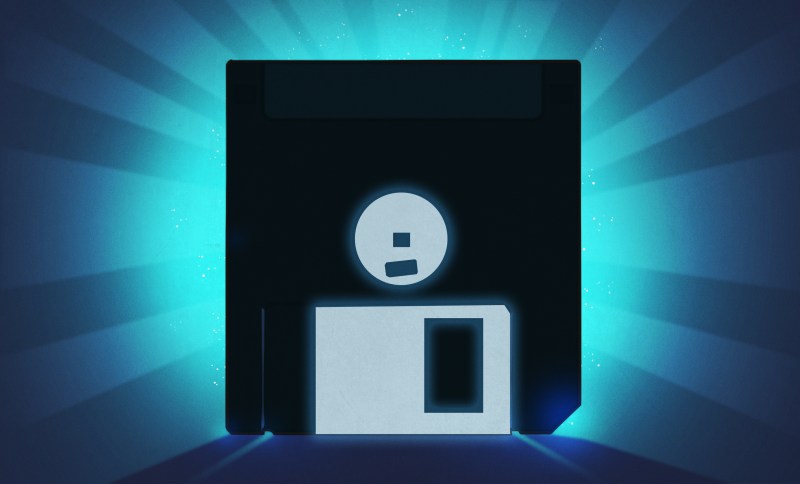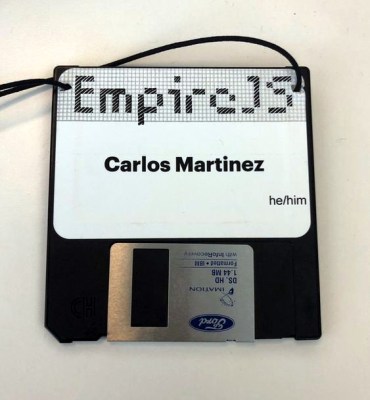
Floppies may be big in Japan, but nostalgic and/or needful Stateside floppy enthusiasts needn’t fret — just use AOL keyword point that browser toward floppydisk.com. There, you can buy new floppies of all sizes, both new and old, recycle your disks, or send them in to get all that precious vintage stuff transferred off of them.
That delightfully Web 1.0 site is owned by Tom Persky, who fancies himself the ‘last man standing in the floppy disk business’. Who are we to argue? By the way, Tom has owned that address since approximately 1990 — evidently that’s when a cyber-squatter offered up the domain for $1,000, and although Tom scoffed at paying so much as $1 for any URL, his wife got the checkbook out, and he has had her to thank for it ever since.
My business, which used to be 90% CD and DVD duplication, is now 90% selling blank floppy disks. It’s shocking to me. — Tom Persky
In the course of writing a book all about yours-truly’s favorite less-than-rigid medium, authors Niek Hilkmann and Thomas Walskaar sat down to talk with Tom about what it’s like to basically sell buggy whips in the age of the electric car.
Tom also owns diskduper.com, which is where he got his start with floppies — by duplicating them. In the 80s and 90s, being in this business was a bit like cranking out legal tender in the basement. As time wore on and more companies stopped selling floppies or simply went under, the focus of Tom’s company shifted away from duplication and toward sales. Whereas the business was once 90% duplication and 10% floppy sales, in 2022, those percentages have flopped places, if you will.
So Who’s Buying Floppies, Anyway?

While the bulk of Tom’s revenue comes from hobbyists, who tend to want working disks, and artists, who probably prefer to use broken ones — his largest customers are the commercial ones. He estimates that about half of the world’s fleet of airliners is over 20 years old and still uses floppies in the avionics. Raise your hand if you were still using floppies in 2002. I know I was, although I also had one of those 100 MB ZIP drives at home.
Tom also cites aging medical equipment that still use floppies, industrial companies that use floppy-based cameras, and his largest customer of them all — the embroidery business. There are tends of thousands of fancy automatic thread-painting machines out there, and they were mostly made when the 3.5″ floppy disk was the height of data storage technology. That’s just how it goes.
Then there’s the hobbyists, artists, and ‘other’ category. ‘Hobbyists’ of course includes the retrocomputering crowd, which likely intersects a bit with ‘other’, which is represented by the sheer number of floppies that have been used as conference badges. Tom says he sold “a lot of disks for that, especially the recycled disks that couldn’t be reformatted.” Wanna bet?
‘Floppy Disk’: An Elegant Name for An Elegant Medium

In this excellent interview, Tom points out that while CDs and DVDs seem futuristic and slick, they are almost as easy to produce as pouring plastic into a mold. Floppies, on the other hand, have several components, around nine of which are unique.
Unlike CDs and DVDs, floppies were a special piece of technology with a complicated manufacturing process. And although older media such as vinyl and cassettes have seen a rebirth, Tom believes that floppies await no such fate.
One could argue that cassette tapes are fairly complicated as well. But consider that data centers and server farmers never really stopped with the tape backups, though they often became relegated to the fourth line of defense.
Although the tapes don’t quite look the same as the Alice In Chains EPs we wore out in middle school, the tooling and equipment to make plastic widgets containing magnetic tape that runs between two spools never went away completely. The same can’t be said of the floppy disk tooling and equipment, which Tom estimates would cost around 25 million dollars to spin up from the dead. I can see it now: Phoenix Floppies. They’ll be fire.
Are Floppies Firmly Obsolete?
While the move to rigid, uni-body plastic-circle media and then USB drives was obviously good for reasons of increased storage, looking back, it feels like a technological bait and switch — a subtle step backward disguised as forward progress. Hey you, look at this shiny new camera array while we take away the headphone jack. The problem, of course, comes when the rest of the industry adopts this type of absurdity, and then companies slowly but surely stop making headphone jacks, or some other elegant, electromechanical thing that served us just fine for decades. I don’t want to be right about this.
At 72, Tom has no plans to get out of the floppy disk business. When asked why he’s still into them today, he jokes that it’s because he forgot to get out, but it’s obvious that Tom fancies floppies more than a little bit. This is a great interview with an awesome guy who sounds just like one of us. “Me, I just like to get up in the morning, have people ask me questions, and try to solve problems.”
0 Commentaires